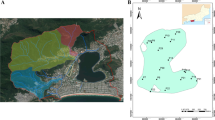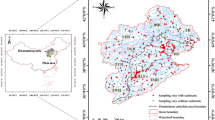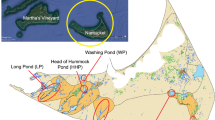Abstract
This study aims to investigate the methylmercury contamination of fish from the Songhua River, China. A total of 328 fish representing various trophic levels were captured from ten reaches of the river and determined for methylmercury by gas chromatography method. Total mercury in fish, water and sediments from three typical reaches were analyzed simultaneously. Methylmercury concentrations in fish from the Second Songhua River and the mainstream of the Songhua River were 0.024 ± 0.016 and 0.015 ± 0.007 mg/kg fresh weight, respectively. The proportion of methylmercury to total mercury ranged from 21.8% to 69.7%, with the mean value of 42.6%. The observed methylmercury concentrations were much lower than the historical values and were generally within the reported literature range, and health hazard assessment showed no health risk from exposure to methylmercury by consuming fish from this river, demonstrating that mercury contamination of the Songhua River has been effectively controlled by nearly 30 years of environmental governance and natural purification.
Similar content being viewed by others
References
Aberg, B., Ekman, L., Falk, R., Greitz, U., Persson, G., & Snihs, J. O. (1969). Metabolism of methylmercury (203Hg) compounds in man. Archives of Environmental Health, 19, 478–484.
Andersen, J. L., & Depledge, M. H. (1997). A survey of total mercury and methylmercury in edible fish and invertebrates from Azorean Waters. Marine Environmental Research, 44(3), 331–350. doi:10.1016/S0141-1136(97)00011-1.
Bakir, F., Damluji, S. F., Amin-Zaki, L., Murtadha, M., Khalidi, A., Al-Rawi, N. Y., et al. (1973). Methylmercury poisoning in Iraq. Science, 181, 230–241. doi:10.1126/science.181.4096.230.
Bank, M. S., Chesney, E., Shine, J. P., Maage, A., & Senn, D. B. (2007). Mercury bioaccumulation and trophic transfer in sympatric snapper species from the Gulf of Mexico. Ecological Applications, 17(7), 2100–2110. doi:10.1890/06-1422.1.
Becker, D. S., & Bigham, G. N. (1995). Distribution of mercury in the aquatic food web of Onondaga lake, New York. Water, Air, and Soil Pollution, 80, 563–571. doi:10.1007/BF01189706.
Bloom, N. S., Watras, C. J., & Hurley, J. P. (1991). Impact of acidification on the methylmercury cycle of remote seepage lakes. Water, Air, and Soil Pollution, 56, 477–491. doi:10.1007/BF00342293.
Dasgupta, S., Onders, R. J., Gunderson, D. T., & Mims, S. D. (2004). Methylmercury concentrations found in wild and farm-raised paddle fish. Journal of Food Science, 69(2), 122–125. doi:10.1111/j.1365-2621.2004.tb15502.x.
Do, H., Kehrig, A., & Malm, O. (1999). Methylmercury in fish as a tool for understanding the Amazon mercury concentration. Applied Organometallic Chemistry, 13(10), 689–696. doi:10.1002/(SICI)1099-0739(199910)13:10<667::AID-AOC955>3.0.CO;2-6
Forsyth, D. S., Casey, V., Dabeka, R. W., & McKenzie, A. (2004). Methylmercury levels in predatory fish species marketed in Canada. Food Additives & Contaminants, 21(9), 849–856. doi:10.1080/02652030400004259.
GIEWS (2008). Global market analysis (p. 42). Food Out-look.
Grieb, T. M., Dricoll, C. T., Gloss, S. P., Schofield, C. L., Bowie, G. L., & Porcella, D. B. (1990). Factors affecting mercury accumulation in fish in the upper Michigan peninsula. Environmental Toxicology and Chemistry, 9, 919–930. doi:10.1002/etc.5620090710.
Harada, M., Akagi, H., Tsuda, T., Kizakit, T., & Ohno, H. (1999). Methylmercury level in umbilical cords from patients with congenital Minamata disease. The Science of the Total Environment, 234(1–3), 59–62. doi:10.1016/S0048-9697(99)00255-7.
Homira, A., Martine, L., Marc, E. S., Mohamad, R. F., & Willy, B. (2007). Total mercury and methylmercury concentrations in fish from the Persian Gulf and the Caspian Sea. Water, Air, and Soil Pollution, 181, 95–105. doi:10.1007/s11270-006-9281-0.
Ikingura, J. R., & Akagi, H. (2003). Total mercury and methylmercury levels in fish from hydroelectric reservoirs in Tanzania. The Science of the Total Environment, 304(1–3), 355–368. doi:10.1016/S0048-9697(02)00581-8.
Ipolyi, I., Massanisso, P., Sposato, S., Fodor, P., & Morabito, R. (2004). Concentration levels of total and methylmercury in mussel samples collected along the coasts of Sardinia Island (Italy). Analytical Chimica Acta, 505(1), 145–151. doi:10.1016/S0003-2670(03)00174-0.
JECFA (2003). 2003 JECFA. In 61st Joint FAO/WHO expert committee on food additives, Rome.
Jin, L. J., & Xu, X. Q. (1997). Methylmercury distribution in surface water and fish in the Three-Gorge Reservoir area. Resources and Environment in the Yangtze alley, 6, 324–328 (in Chinese).
Jin, L. N., Liang, L. N., Jiang, G. B., & Xu, Y. (2006). Methylmercury, total mercury and total selenium in four common freshwater fish species from Ya-Er Lake, China. Environmental Geochemistry and Health, 28(5), 401–407. doi:10.1007/s10653-005-9038-5.
Kannan, K., Smith, R. G., Lee, R. F., Windom, H. L., Heitmuller, P. T., Macauley, J. M., et al. (1998). Distribution of total mercury and methylmercury in water, sediment and fish from South Florida estuaries. Archives of Environmental Contamination and Toxicology, 34, 109–118. doi:10.1007/s002449900294.
Kelly, C. A., Rudd, J. W. M., & Holoka, M. H. (2003). Effect of pH on mercury uptake by an aquatic bacterium: Implications for Hg cycling. Environmental Science and Technology, 37(13), 2941–2946. doi:10.1021/es026366o..
Koller, L. D., Exon, J. H., & Arbogast, B. (1997). Methylmercury: Effect on serum enzymes and humoral antibody. Journal of Toxicology and Environmental Health, 2(5), 1115–1123. doi:10.1080/15287397709529509.
Kružíková, K., Svobodová, Z., Valentová, O., Randák, T., Velíšek, J. (2008a). Mercury and methylmercury in muscle tissue of chub from the Elbe River main tributaries. Czech Journal of Food Science, 26, 65–70.
Kružíková, K., Randák, T., Kenšovál, R., Kroupová, H., Leontovyčová, D., Svobodovál, Z. (2008b). Mercury and methylmercury concentrations in muscle tissue of fish caught in major rivers of the Czech Republic. Acta Veterinaria Brno, 77, 637–643. doi:10.2754/avb200877040637.
Li, H. W., Yan, B. X., Xu, Z. G., & Zhang, F. S. (2006). Spatial and temporal distribution of total mercury (T-Hg) in water of Songhua River. China Journal of Environmental Sciences, 26(5), 840–845 (in Chinese).
Liu, Y. M., Wang, R. H., & Zhai, P. Y. (1998). Controls and standards on methylmercury pollution of Songhua River in China. Beijing: Science (in Chinese).
Liu, J. R., Dong, H. W., Tang, X. L., Sun, X. R., Han, X. H., Chen, B. Q., et al. (2009). Genotoxicity of water from the Songhua River, China, in 1994–1995 and 2002–2003: Potential risks for human health. Environmental Pollution, 157(2), 357–364. doi:10.1016/j.envpol.2008.10.004.
Mahaffey, K. R. (1999). Methylmercury: A new look at the risks. Public Health Reports, 114(5), 397–402.
Mason, R. P., & Svinsdottir, A. Y. (2003). Mercury and methylmercury concentrations in water and largemouth bass in Maryland reservoirs (pp. 86). Final Report submitted to Maryland Department of Natural Resources, CBWP-MANTA-AD-03-1.
Myers, G. J., & Davidson, P. W. (1998). Prenatal methylmercury exposure and children: Neurologic, developmental, and behavioral research. Environmental Health Perspectives, 106(3), 841–847.
Oken, E., Wright, R. O., Kleinman, K. P., Bellinger, D., Amarasiriwardena, C. J., Hu, H., et al. (2005). Maternal fish consumption, hair mercury, and infant cognition in a U.S. cohort. Environmental Health Perspectives, 113, 1376–1380. doi:10.1289/ehp.8041.
Philip, W. D., Gary, J. M., & Bernard, W. P. (2004). Mercury exposure and child development outcomes. American Academy of Pediatrics, 113(4), 1023–1029. doi:10.1542/peds.113.4.S1.1023.
Saiki, M. K., Martin, B. A., May, T. W., & Alpers, C. N. (2010). Mercury concentrations in fish from a Sierra Nevada foothill reservoir located downstream from historic gold-mining operations. Environmental Monitoring and Assessment, 163, 313–326. doi:10.1007/s10661-009-0836-6.
Schober, S. E., Sinks, T. H., Jones, R. L., Bolger, P. M., Dowell, M. M., Osterloh, J., et al. (2003). Blood mercury levels in U.S. children and women of childbearing age, 1999–2000. The Journal of the American Medical Association, 289(13), 1667–1674. doi:10.1001/jama.289.13.1667.
She, Z. S., Meng, X. X., & Zhu, Y. M. (1982). An analisis of the present pollution of water quality in the Second Songhua River Basin and its characteristics. In Changchun Branch of Chinese Academy of Sciences. Proceeding of the Second Songhua River symposium on environmental sciences (pp. 39). Changchun, China: Jilin People’s Publishing House (in Chinese).
Sun, X. J., Wang, Q. C., Zhang, S. Q., Zhang, X. W., Zhang, X. Y., & Zhang, Z. S. (2009). Temporal and spatial variation of methylmercury in sediments in the Second Songhua River, China. Soil and Sediment Contamination, 18(3), 284–293. doi:10.1080/15320380902772679.
Takizawa, Y., & Kitamura, S. (2001). Estimation of the incidence of mercury exposure in the Minamata and Niigata areas using mathematical model from Iraqi poisoning. In Y. Takizawa, & M. Osame (Eds.), Understanding Minamata disease: Methylmercury poisoning in Minamata and Niigata, Japan (pp. 27–32). Tokyo: Japan Public Health Association.
Tomiyasu, T., Yonehara, N., Sakamoto, H., Rifardi, Oki, K., Akagi, H., et al. (2000). Mercury contamination in the Yatsushiro Sea, south-western Japan: Spatial variations of mercury in sediment. The Science of the Total Environment, 257(2–3), 121–132. doi:10.1016/S0048-9697(00)00502-7.
UNEP Chemicals Branch (2008). The global atomospheric mercury assessment: Soures, emissions and transport (p. 2). Geneva: UNEP-Chemicals.
U.S. EPA (1996). The Integrated Risk Information System (IRIS) on-line. Washington, D.C.: National Center for Environmental Assessment.
Wang, Q. R., Kim, D., Dionysiou, D. D., George, A., & Dennis, T. (2004). Sources and remediation for mercury contamination in aquatic systems-a literature review. Environmental Pollution, 131(2), 323–336. doi:10.1016/j.envpol.2004.01.010.
WHO (1990). Methylmercury. In Environmental health criteria (p. 145). Geneva: World Health Organization.
Yan, H. Y., Feng, X. B., Liu, T., Shang, L. H., Li, Z. G., & Li, G. H. (2008). Present situation of fish mercury pollution in heavily mercury contaminated Baihua reservoir in Guizhou. China Journal of Ecology, 27(8), 1357–1361 (in Chinese).
Yasutake, A., Nagano, M., & Nakano, A. (2005). Simple method for methylmercury estimation in biological samples using atomic absorption spectroscopy. Journal of Health Science, 51(2), 220–223.
Zhang, L., & Wang, Q. C. (2006). Preliminary study on health risk from mercury exposure to residents of Wujiazhan town on the Di’er Songhua river, Northeast China. Environmental Geochemistry and Health, 28(1–2), 67–71. doi:10.1007/s10653-005-9013-1.
Zhang, Z. S., Sun, X. J., Wang, Q. C., Zheng, D. M., Zheng, N., & Lv, X. G. (2009). Recovery from Mercury Contamination in the Second Songhua River, China. Water, Air and Soil Pollution, 211(1–4), 219–229. doi:10.1007/s11270-009-0294-3.
Zhu, H., Yan, B. X., & Li, H. W. (2010). Total mercury and mercury species in sediments of the Songhua River. Journal of Ecology and Rural Environmental, 26(3), 210–214 (in Chinese).
Author information
Authors and Affiliations
Corresponding author
Rights and permissions
About this article
Cite this article
Zhu, H., Yan, B., Cao, H. et al. Risk assessment for methylmercury in fish from the Songhua River, China: 30 years after mercury-containing wastewater outfalls were eliminated. Environ Monit Assess 184, 77–88 (2012). https://doi.org/10.1007/s10661-011-1948-3
Received:
Accepted:
Published:
Issue Date:
DOI: https://doi.org/10.1007/s10661-011-1948-3




